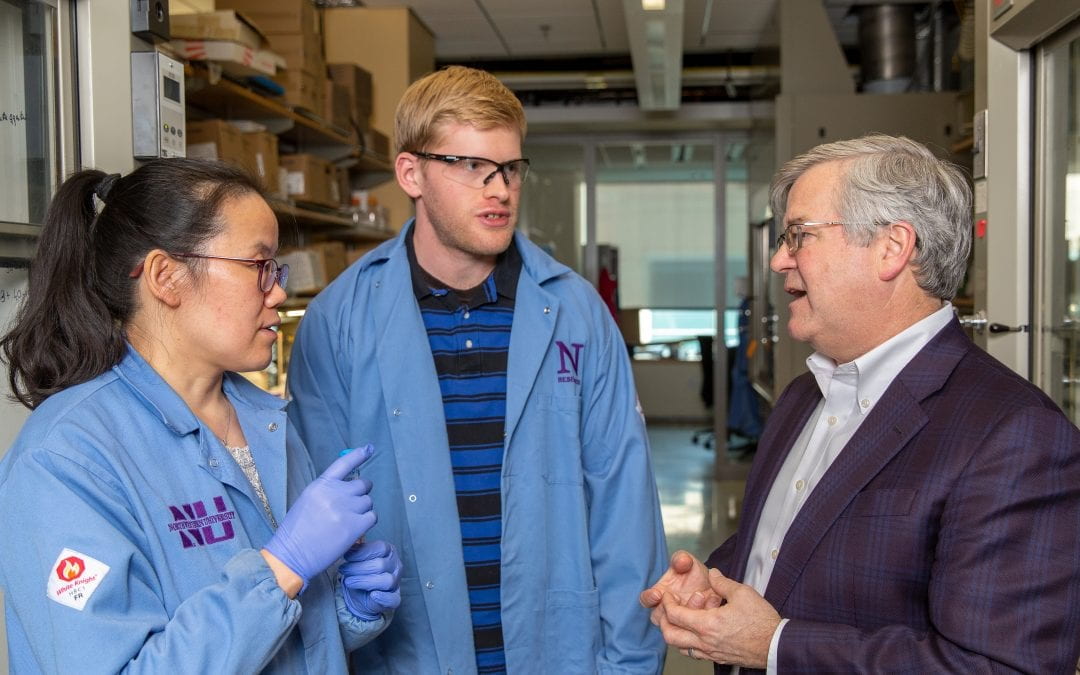
Program Coordinator:
Cristin Connerty
ohalloran-ofc@northwestern.edu
847-467-0965

Fighting Cancer with a Famous Poison
Thomas O’Halloran
Charles E. and Emma H. Morrison Professor of Chemistry and Professor of Molecular Biosciences, Weinberg College of Arts & Sciences; Professor of Medicine, Division of Hematology and Oncology, Feinberg School of Medicine
Founding Director, Chemistry of Life Processes Institute
Director, Center for Developmental Therapeutics
Director, Quantitative Bio-element Imaging Center
Principal Investigator, Physical Sciences-Oncology Center
Thomas V. O’Halloran, PhD, is a widely respected and internationally recognized expert in bioinorganic chemistry. His research focuses on understanding how receptors for metals such as copper, iron and zinc regulate cellular functions across organisms that span the tree of life. Using genetic, chemical, structural and mechanistic approaches, he and his collaborators have discovered new types of metal-binding proteins, defined their structures, functions and mechanisms and tied their function to a number of disease-related physiological processes. Among many other breakthroughs, O’Halloran and collaborators discovered that zinc fluxes control fundamental developmental decisions in bacteria, diseases-causing parasites and fertilization of mammalian eggs. Over five hundred press pieces have been published about the zinc fluxes and sparks that accompany fertilization of mammalian eggs. Discover Magazine listed the paper on the zinc spark in human eggs as one of the top 100 scientific discoveries of 2016.
O’Halloran is the Charles E. and Emma H. Morrison Professor in Chemistry and Professor of Molecular Biosciences in the Weinberg College of Arts & Sciences and Professor in the Department of Medicine, Division of Hematology and Oncology in the Feinberg School of Medicine at Northwestern University. He is the Founding Director of the Chemistry of Life Processes Institute (CLP) and Director of the Institute’s Quantitative Bio-element Imaging Center and Center for Developmental Therapeutics. O’Halloran is the Principal Investigator of the Chicago Region Physical Science-Oncology Center (CR-PSOC), a partnership between CLP and the Robert H. Lurie Comprehensive Cancer Center of Northwestern University.
As Founding Director of CLP, O’Halloran is responsible for the overall scientific leadership, strategic planning, financial oversight and day-to-day management of the Institute. He works with the Deans of three colleges, the Vice President for Research, the Directors of five Centers and the chairs of eight departments to recruit faculty, govern space assignments and allocate resources in the Institute’s 100,000 NSF building Silverman Hall. Among his many responsibilities, O’Halloran organizes and leads teams of interdisciplinary biomedical researchers who have formed dozens of team-based, multidisciplinary biomedical research collaborations that have received extensive peer review funding. CLP supports five university-wide centers and nine core facilities. The Institute has accelerated the development of more than 75 new drug candidates, medical devices, and diagnostics, collectively, toward clinical trials. Since the Institute’s inception, 33 new companies have spun out of the Institute and received external investments exceeding $2.5 billion. Under O’Halloran’s leadership, the Institute has evolved a broad ecosystem for interdisciplinary training in the life sciences that fosters the next generation of biomedical innovators.
O’Halloran co-founded several successful biomedical startups including Tactic Pharma that led to the spin-out of Monopar Therapeutics, the largest first day increase for IPO since 2005.
Among his many awards and honors, O’Halloran gave the Annual Dewitt Stetten Jr. Lecture at NIH in September 2016 and is a Fellow of the American Association for the Advancement of Science and of the Royal Society of Chemistry.
Publications
Philips SJ, Canalizo-Hernandez M, Yildirim I, Schatz GC, Mondragón A, O’Halloran TV. Allosteric transcriptional regulation via changes in the overall topology of the core promoter. Science. 2015 Aug 21;349(6250):877-81.
Que EL, Bleher R, Duncan FE, Kong BY, Gleber SC, Vogt S, Chen S, Garwin SA, Bayer AR, Dravid V, Woodruff TK, O’Halloran TV. Quantitative mapping of zinc fluxes in the mammalian egg reveals the origin of fertilization-induced zinc sparks. Nature Chemistry (2015) Feb;7(2):130-9. doi: 10.1038/nchem.2133. Epub 2014 Dec 15.
Gilston BA, Wang S, Marcus MD, Canalizo-Hernandez MA, Swindell EP, Xue Y, Mondragon A, O’Halloran TV. “Structural and Mechanistic Basis of Zinc Regulation Across the E. coli Zur Regulon” PLoS Biology (2014). Nov 4;12(11):e10011987.
Miodragovic DU, Quentzel JA, Kurutz JW, Stern CL, Ahn RW, Kandela I, Mazar AP, O’Halloran TV. “Robust Structure and Reactivity of Aqueous Arsenous Acid-Platinum (II) Anticancer Complexes.” Angew. Chem. Int. Ed. Engl., 2013. 52;1-5.
Kim AM, Bernhardt ML, Kong BY, Ahn RW, Vogt S, Woodruff TK, O’Halloran TV. Zinc sparks are triggered by fertilization and facilitate cell cycle resumption in mammalian eggs. ACS Chemical Biology., Jul 15;6(7):716-23.
Alvarez HM, Xue Y, Robinson CD, Canalizo-Hernandez MA, Marvin RG, Mondragon A, Penner-Hahn JE, O’Halloran TV. Tetrathiomolybdate Inhibits Copper Trafficking Proteins Through Metal Cluster Formation.Science. 2010 Jan 15;327(5963):331-4.
Select Honors and Awards
- Royal Society of Chemistry Dalton Award for Bioinorganic Chemistry (2013)
- Fellow, Royal Society of Chemistry (2013)
- David Denks Award for Research on Copper Homeostasis & its Disorders (2008)
- Fellow, Japanese Society for the Promotion of Science (2007)
- MERIT award, National Institutes of Health (2001-2010)
- Fellow, American Association for the Advancement of Science (1999)
- Guggenheim Fellow, John Simon Guggenheim Memorial Foundation (1998-1999)